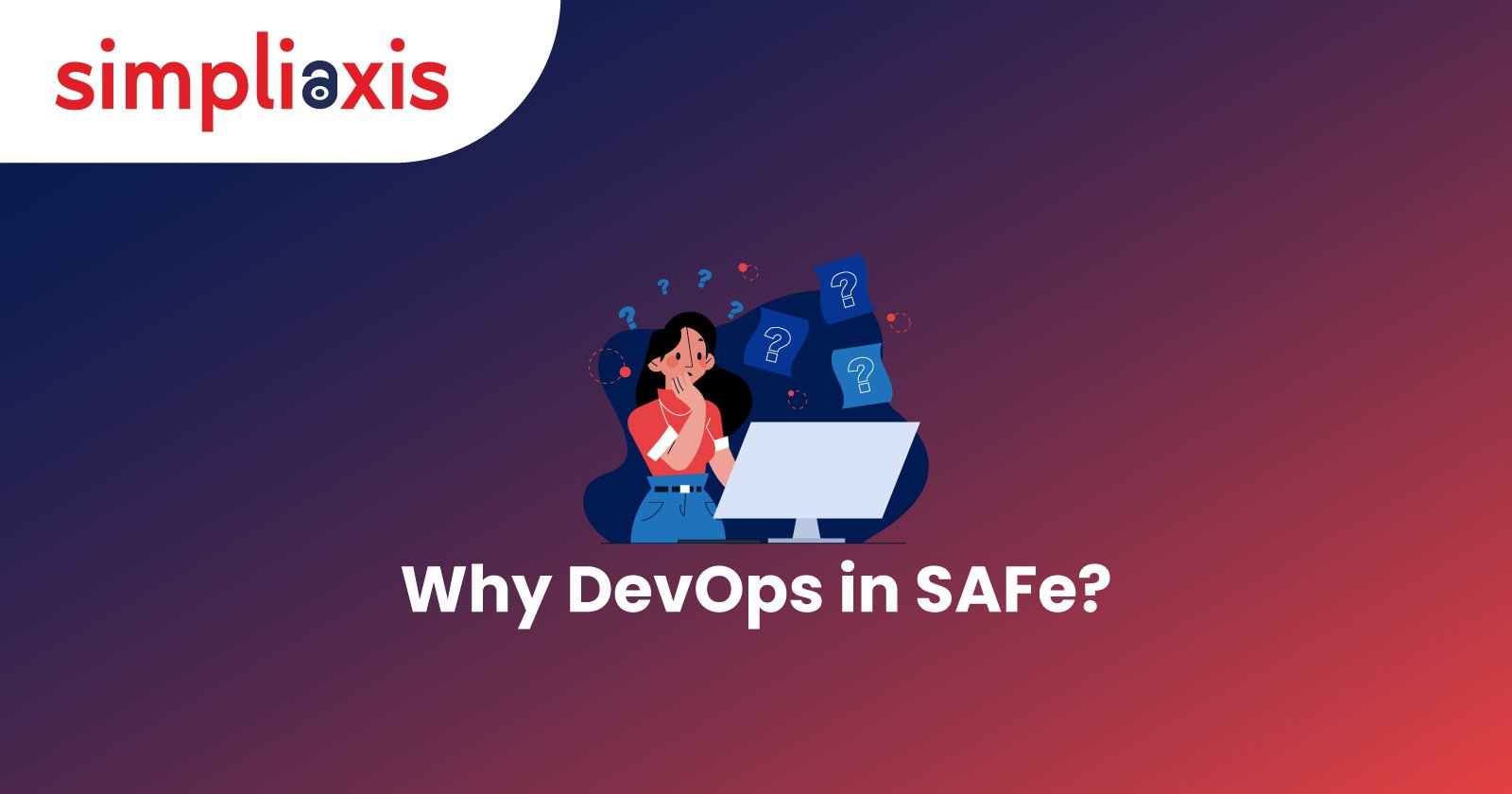Have you ever heard of DevOps? It is a combination of two different concepts—development and IT operations. DevOps usually assists in software production, including deployment, in a repeatable and automated manner. These practices are effective because they help organizations increase their respective speed. You can achieve great speed by delivering your software services and applications on time.
With DevOps, anyone can better serve their customers. In fact, you may also gain the power to compete in the market more effectively. Most of the time, DevOps, an alignment of information technology operations and development, is associated with the Scaled Agile Framework (SAFe). So, why does this alignment happen? Let's find out.
Why is DevOps Required?
The DevOps market sizs internationally is expected to grow at an estimated rate of $57.90 billion by 2030, with a CAGR registration of 24.2%. This proves the increasing demand for the practice across organizations and industries. Now, let us learn the exact reasons behind the growing importance of DevOps in software development and IT operations.
Maximizing Efficiency with Automation
DevOps enables effective business transformation that includes people, process and culture change. Most strategies related to DevOps transformation focus on different structural improvements that build a particular community. A successful DevOps initiative often requires a cultural or mindset change across organizations. This specific change enables collaboration between multiple teams and automation to achieve business goals.
Hence, DevOps emphasizes deploying software reliably and securely through automation by managing end-to-end engineering processes.
Optimizing the Entire Business
DevOps always provides excellent insights across organizations. It further forces the respective management to "optimize for the whole system," apart from the IT siloes. In short, DevOps aims to improve the business as a whole. This enables the teams to be more adaptive and data-driven to align their goals with customer and business needs.
Improving Stability and Speed of Software Development and Deployment
Most top-performing DevOps organizations perform better on software development speed and stability. It further helps them achieve the key operational requirements of ensuring their respective product or service is available to end users. The 2019 Accelerate report includes five performance metrics—lead time, deployment frequency, change fail, time to restore, and availability. These five metrics deliver an efficient view of software delivery and performance.
Getting The Business to Focus on What Matters Most: People
People are the most critical component of any specific DevOps initiative. They can greatly increase a particular business's odds of success. For instance, the DevOps evangelist proves to be a persuasive leader who can explain the benefits of the greater agility of DevOps practices to the business. Automation systems are also crucial to DevOp's success. So, an automation specialist can develop strategies for continuous deployment and integration. This process ensures that production and pre-production systems are flexible, software-defined, adaptable, and available.
Understanding the Basics of DevOps Concepts within SAFe
SAFe defines DevOps as a set of technical practices that involve a culture and a mindset. These practices enable close cooperation, integration, automation, and communication. It proves to be helpful for all people engaged in releasing, deploying, maintaining, testing, developing, and even planning a particular solution.
DevOps will be part of a Lean enterprise's overall Agile Product Delivery competency. The absence of these practices may lead to increased tension between several building solutions.
SAFe enterprises often implement different DevOps practices to break down the organizational silos. Most of the time, it is done to develop a Continuous Delivery Pipeline or CDP. This is a higher-performance innovation engine that can deliver market-leading solutions at the pace of a particular business.
The need to streamline software development, including the associated delivery processes, led to the emergence of DevOps in SAFe. Implementing DevOps within the SAFe can yield several benefits. This helps smoothen the efficiency of software development and delivery at scale. Here are some key benefits of integrating DevOps in SAFe:
Accelerated Delivery
DevOps practices in SAFe enable faster and more frequent releases. It ensures that valuable features reach end-users at an accelerated pace. Continuous integration and continuous delivery (CI/CD) pipelines streamline the deployment process to reduce lead times.
Improved Collaboration
DevOps enhances collaboration between development, operations, and other cross-functional teams. This often aligns with SAFe's emphasis on collaboration at both team and program levels. This improved communication signals a better understanding and shared goals.
Enhanced QualityBenefits of DevOps in SAFe
Automated testing, continuous integration, and continuous delivery in DevOps contribute to higher software quality. By identifying and addressing issues early in the development cycle, the probability of issues in the final product is significantly reduced. This aligns with SAFe's commitment to delivering high-quality software.
Efficient Release Management
SAFe emphasizes the importance of coordinated release planning across Agile Release Trains (ARTs). DevOps practices further enhance release management by automating deployment processes. It aims to ensure consistency and reduce the potential for human error.
Greater Visibility and Transparency
DevOps tools and practices provide real-time visibility into the development and delivery pipeline. This transparency aligns with SAFe principles to promote visibility at all organizational levels, from teams to portfolios.
Rapid Feedback Loops
DevOps enables rapid feedback loops through continuous monitoring, automated testing, and frequent releases. This aligns with SAFe's principles of applying Lean and Agile practices to achieve faster learning cycles and adaptability.
Infrastructure as Code (IaC)
DevOps helps implement Infrastructure as Code (IaC), which is also aligned with SAFe's emphasis on lean and agile practices. IaC enhances the consistency, traceability, and scalability of infrastructure configurations.
Continuous Improvement
DevOps practices encourage a culture of continuous improvement to align with SAFe's principle of relentless improvement. Teams can regularly assess and enhance their processes, tools, and collaboration practices for better outcomes.
Flexibility and Adaptability
DevOps practices support the adaptability and flexibility required in a dynamic SAFe environment. Teams can instantly respond to market conditions, changing environments, or customer feedback. It often aligns with SAFe's Agile and Lean principles.
Reduced Lead Time and Time-to-Market
Combining SAFe and DevOps shortens lead times by optimizing processes and minimizing delays between development and deployment. This means more time-to-market for new features and improvements.
Integration of DevOps Practices in SAFe
There are some challenges during integrating DevOps practices in SAFe for software development. These include:
Planning and Execution
SAFe strongly emphasizes meticulous planning and coordinating efforts across multiple teams to achieve a common objective. In contrast, DevOps prioritizes flexibility and responsiveness during execution, relying on continuous feedback and iteration. The potential conflict arises when SAFe's planning becomes overly rigid, hindering DevOps teams from promptly adapting to changing requirements.
Continuous Improvement
While both SAFe and DevOps emphasize continuous improvement, they approach it differently. DevOps focuses on rapid value delivery and incorporates user feedback dynamically. SAFe, on the other hand, emphasizes a more structured and deliberate approach to continuous improvement. The challenge here lies in balancing improvement efforts with delivering value quickly and adapting to evolving requirements. Improvement initiatives may become disconnected from the overall project or organizational objectives.
Despite the above challenges, integrating DevOps into SAFe practices is important. You can make it possible by following these steps associated with the CAMLR approach.
Culture
In the context of CAMLR, culture refers to fostering a shared responsibility between operations and development teams. This collaborative culture ensures that both teams actively participate in the software delivery process.
Automation
Automation involves dynamically creating and dismantling the development environment, aiming to replicate deployment, test automation, and production processes. Automation is essential for achieving continuous integration, deployment, and on-demand release capabilities.
Lean Flow
Lean Flow emphasizes the efficient delivery of software by implementing smaller batch sizes. This involves limiting Work in Progress (WIP), providing real-time visibility into software development, reducing costs, increasing release frequency, minimizing rework, accelerating feedback loops, and enhancing predictability.
Measurement
Measurement focuses on quantifying and improving the flow of delivery. Utilizing tools like Kanban to map the entire delivery pipeline, organizations can evaluate metrics such as lead time and cycle time. Telemetry is employed to monitor servers and applications, enabling data-driven decision-making.
Recovery
Recovery involves real-time monitoring of scalability and redundancy to ensure swift recovery in case of failures. By proactively monitoring and addressing potential issues, organizations can maintain a high level of system reliability and responsiveness.
Measuring and Managing DevOps Maturity
DevOps maturity models help assess how an organization progresses in adopting DevOps practices. While specific models may differ based on company size, industry, and goals, common stages offer a general roadmap for improvement. Let's explore the most prevalent stages in DevOps maturity:
Stage 1: Initial (or Ad Hoc)
At this starting point, DevOps practices are either absent or disjointed. Organizations face various software development challenges, including limited collaboration, manual tasks, and buggy releases. Key characteristics include:
- Siloed operations, security, development, and product teams.
- Manual build steps and reliance on a waterfall approach.
- Lack of automation and prolonged release cycles.
- Reactive problem-solving rather than value addition.
- Manual infrastructure creation and updates.
Stage 2: DevOps in "Pockets"
Organizations in this stage implement some DevOps practices, emphasizing inter-team collaboration and automation. While workflows become more streamlined, processes lack clear definitions. Main traits include:
- Collaboration between developers and Ops on smaller projects.
- Emphasis on big feature releases.
- Agile practices have been introduced but are struggling to break down services into microservices.
- Automation efforts, but some follow "automation for automation's sake."
- Testing is always a part of the wider development process.
Stage 3: Defined, Automated, And More Consistent
Organizations establish well-defined and standardized processes across development and operations in this stage. Key characteristics involve:
- Regular communication between Ops and engineering teams.
- Focus on frequent, incremental deployments.
- Automation of various processes for repeatability.
- Self-service cloud computing resources.
- Integration of security scans throughout the DevOps pipeline.
Stage 4: Highly Optimized DevOps
Companies at this stage prioritize measuring success based on user experience and business objectives. Characteristics include:
- Close collaboration between Ops, development, project management, and security teams.
- Almost entirely automated deployment processes.
- Continuous, incremental software updates.
- Development and operations always work in similar technical environments.
- Embracement of lean practices, minimal interruptions, and mature Agile processes.
Stage 5: Fully Mature DevOps
Organizations using DevOps maturity optimize their pipeline through several data-driven insights. Characteristics include:
- Code changes reach production with zero human intervention.
- Multiple deployments daily with certainty and minimal risk.
- High levels of collaboration, leading to DevSecOps.
- Maximum uptime, no interruptions to customer experience.
- Innovation and experimentation are encouraged.
Meanwhile, here are key metrics to measure DevOps maturity, providing insights into the efficiency and effectiveness of development and operations processes:
- Time-to-Market: The duration from ideation to product launch.
- Lead Time: The time between code deployment and its commitment.
- Deployment Frequency: The frequency of deployments within a specified timeframe.
- Code Quality: Metrics assessing code health, including complexity, coverage, and review feedback.
- Code Deployment Success Rate: The percentage of deployments that are successful.
- Change Failure Rate: The percentage of deployments failing.
- Rollback Rate: The percentage of deployments that necessitate a rollback.
- Error Budget: The acceptable rate of failures or errors in production.
- Availability: The percentage of time the system is fully operational and available.
- Scalability: The system's ability to handle increased loads without performance issues.
- Time-in-Stage: The average time taken to complete each stage of the software development lifecycle.
- Code Review Feedback Loop Time: The duration to receive feedback and implement changes following code reviews.
- MTTR (Mean Time to Recovery): The average time taken to recover from a failure.
- MTTD (Mean Time to Detect): The average time taken to detect a problem.
- MTTA (Mean Time to Acknowledge): The average time taken to acknowledge and start working on a problem.
Conclusion
While the implementation of DevOps in SAFe is far from guaranteed success, such frameworks always help map the adoption journey across organizations. Yet, how can you avoid common roadblocks and drive decision-making in the right direction when using such practices? This must involve getting a clear overview of your DevOps and where the practices are falling short. The professional DevOps certification courses from Simpliaxis can enable you to learn how to correct such mistakes and maximize your ROI. This may involve doing the DevOps Foundation® Certification Training or the DevSecOps Foundation DSOF℠ based on your requirements. So, go ahead, choose your desired certification from Simpliaxis and become a certified DevOps professional now.













 +1-361-998-9988
+1-361-998-9988


